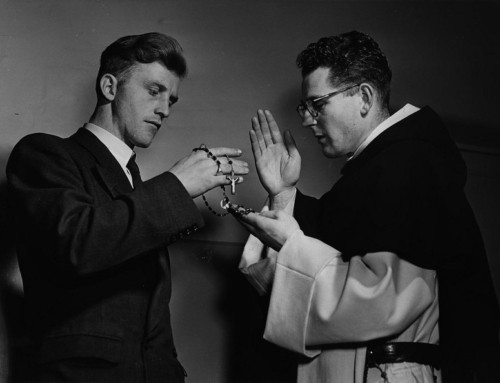Dennis Bonnette, Origin of the Human Species. Ave Maria, Florida: Sapientia Press, 2014.
Catholics in the 21st century are constantly bombarded with scientific research that seems to question the validity of Christian belief. This is particularly true in the case of evolutionary research where it seems we must accept either creation or evolution. Need this be the case? Can we not have both? And if we try to hold to the Church’s teaching, how are we to respond to those who think that science proves the contrary? This is precisely the task that Bonnette boldly takes up in Origin of the Human Species.
There are two ways to approach the debate. The first, more popular approach presents a solution to other philosophers on how to reconcile evolution and creation. Bonnette, however, takes the less traveled path. In his book, he lays out the various scientific claims pertaining to the evolution-creation debate, then responds to each, and, thus, actually engages the scientific community. At the end of the book, the reader comes away with a strong sense of Bonnette’s own position. But what is even more valuable is a better sense of how to engage, analyze, and respond to the various claims of modern research.
Bonnette first discusses the shear possibility of evolution and where, if anywhere, God fits in. He sets the question of man aside temporarily and looks at the origin of life in general. Can a non-living thing evolve into a living organism? Evolutionary biology immediately answers in the affirmative. However, at first glance, philosophy might argue that direct divine intervention is necessary. “Miraculous divine intervention [is required] to enable a creature to produce an effect exceeding its natural limits.” For instance, it would be a miracle if I started speaking Chinese without having studied it before. Likewise a non-living thing needs a miracle to turn itself into a living thing.
Bonnette offers a solution by introducing the philosophical notion of chance whereby an event occurs that is outside the agent’s intention. For instance, two people decide to go to the store but are unaware that the other is going. They do not intend to meet, and so it is by chance that they see each other. Likewise, in non-life becoming life, the interaction of various molecules is such that by their nature they cannot produce life by themselves. However, by acting according to their nature and through a series of chance-events in their interactions with other molecules and the environment, matter is re-organized such that life emerges.
While this is possible without a miraculous divine intervention, it does not remove God from the process. On the contrary, God preordains the event as he stands outside of time, “foresees the natural effects of creatures[,] and creates a world where created [non-living] natures naturally give rise to life.” From this notion of what he calls natural extrinsic bioteleologism, Bonnette writes, “What appears as chance to some and molecular determinism to others would be, from God’s perspective, the eternally foreknown process of generating a world of living things.”
Bonnette proceeds to discuss the evolution of man from non-rational animals. He produces the standard argument for the necessity of divine intervention. Since evolution deals only with matter and man’s soul is incorporeal, man’s body may evolve from lower animals but his soul cannot evolve. Therefore, God intervened and infused a rational soul into a properly disposed body.
Bonnette contributes to this topic with a much needed analysis of ape-language studies. Scholars argue for the presence of rationality in apes based on the ability to form sentences, lie to others, and correct one another’s mistakes. However, after a careful analysis of the data, Bonnette illustrates that some scientists fall into the fallacy of anthropomorphism, attributing undue human characteristics to behaviors observed in apes. For Bonnette, only when apes begin the process of self-reflection, correct their own mistakes, and communicate universal ideas can scientists rightly conclude the presence of rationality.
The final major section analyzes the attempts of the scientific community to find the first human being(s). Bonnette’s approach is to conclude that mankind must have been present when rationality was present. He places the origin of man—and thus Adam and Eve—as late as 500,000 BC in the population of homo erectus. He makes this claim based on aesthetics. At this time, Acheulean tools arose that illustrate a concern for aesthetics and in particular for artistic symmetry. Bonnette concludes that this demonstrates a universal understanding of shapes indicative of rationality. However, while he spends over thirty pages debunking the claims of ape-language studies, he dedicates only a few pages to the argument of rationality from aesthetics. Ultimately, he fails to articulate why those tool makers could not have simply found pleasure in this particular symmetrical shape as opposed to pleasure in universal shapes. Non-rational animals can experience pleasure in individual things like the sound of a master’s voice or the shape of a dog bone. Rationality, however, allows a person to think about and enjoy abstract ideas. Experiencing pleasure because of the shape of a particular tool does not necessitate thinking about the idea of symmetry and concentric circles. The latter is required to prove the presence of rationality.
This is the one section that leaves the reader with something to be desired. On the one hand, we can look to whom he is responding. While a sizeable portion of his audience are Christians who desire to reconcile science and faith from a philosophical perspective, the content is a response to scientists. These scientists would largely agree that artistic symmetry is indicative of rationality, and, so, he has minimal convincing to do. However, for the reader who is inclined to place the origin of man later rather than earlier, a more thorough defense of the aesthetic argument is necessary.
This single issue is, however, no reason to dismiss the book’s achievements. No single book could adequately resolve every issue in the debate over the origins of man. Instead of claiming such an attempt, Bonnette simply begins a philosophical analysis of the scientific claims. For this reason we must applaud the book. Instead of dialoguing with other philosophers, he does what is so desperately needed. He responds to the scientists themselves and, in so doing, teaches the reader how to continue the dialogue.
To download a printable PDF of this Article from
Dominicana Journal, Winter 2014, Vol LVII, No. 2, CLICK HERE.



